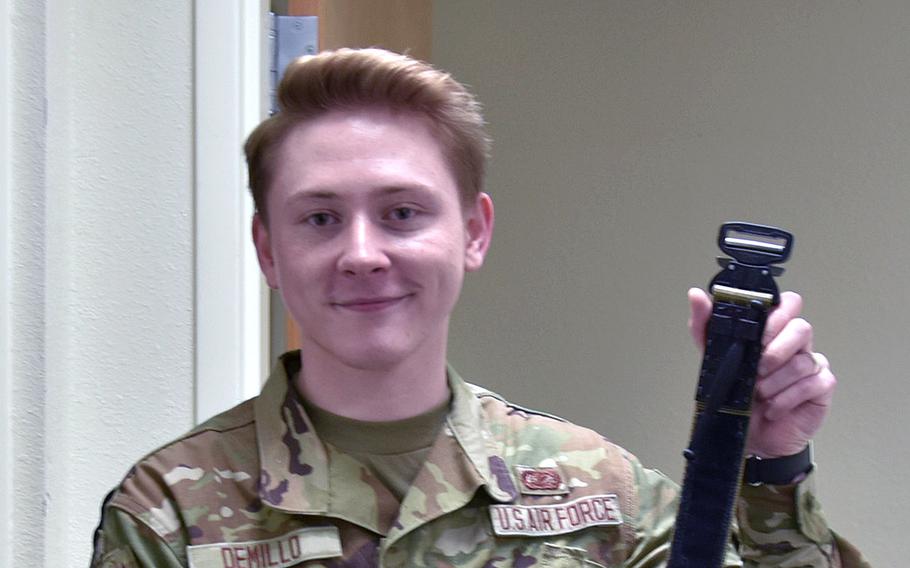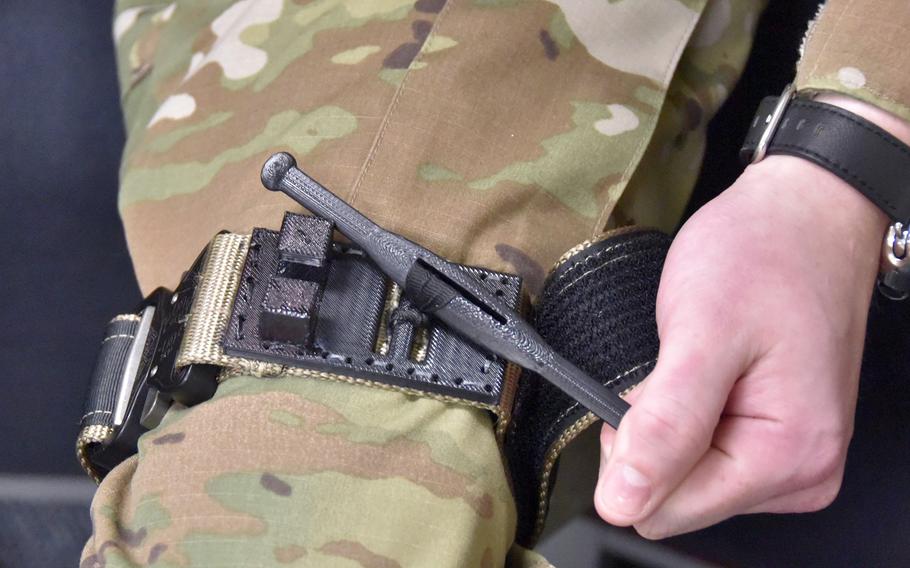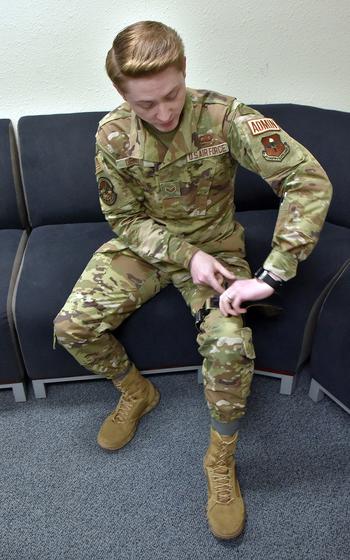
Senior Airman Isaiah Demillo, a country liaison with the 82nd Training Support Squadron, holds up his invention, the Demillo rigger’s tourniquet belt, on June 6, 2024, at Sheppard Air Force Base, Texas. (Julie Svoboda/U.S. Air Force)
An airman’s invention aims to make a lifesaving device wearable and easily accessible in an emergency.
It also just might earn him some extra cash.
Senior Airman Isaiah Demillo, 23, stationed at Sheppard Air Force Base in Texas, applied for a patent in February for the Demillo Rigger’s tourniquet belt.
This week, the country liaison for the 82nd Training Support Squadron will head to a six-week Air Force course in Pittsburgh to refine his prototype and get the backing of medical experts before seeking wide-scale adoption.
Demillo, from Denver, Colo., joined the Air Force in 2021 and a year later found himself asking questions during a Tactical Combat Casualty Care course.
“They told us to never use a belt because it doesn’t generate the pressure needed to stop massive bleeding,” he said. “It’s because the belt was missing the spinning portion that applies pressure with the (combat application) tourniquet. So I thought to myself, ‘Add one.’”

Senior Airman Isaiah Demillo, a country liaison with the 82nd Training Support Squadron, demonstrates how to use the Demillo rigger’s tourniquet belt, on June 6, 2024, at Sheppard Air Force Base, Texas. (Julie Svoboda/U.S. Air Force)
The belt can be worn with operational camouflage pattern uniforms and is designed to be self-applied. Demillo hopes it will one day be sold in base exchanges and recommended in the very combat care course that spurred the idea.
“I couldn’t tell you where my nearest tourniquet in this building is right now,” he said. “So if somebody has it on their waist and it’s constantly on them and it’s a part of your uniform, it’s integrated into your lifestyle.”
Demillo wasn’t the first to imagine a tourniquet on a belt, but existing models used a ratchet to tighten the device, which could lead to tissue damage, he said.
He wrote up his concept and reached out to the base’s Spark Cell, which is part of a network of innovation offices at Air Force bases around the world.
The cell referred him to a patent lawyer at Wright-Patterson Air Force Base in Ohio. He began deconstructing tourniquets and planning what his product would look like before making a computer-aided drafting file.

Senior Airman Isaiah Demillo, a country liaison with the 82nd Training Support Squadron, demonstrates how to use the Demillo rigger’s tourniquet belt, on June 6, 2024, at Sheppard Air Force Base, Texas. (Julie Svoboda/U.S. Air Force)
He contacted other units to help him 3D print and sew on the device. The initial prototype cost about $46.
Demillo signed away a portion of his rights to proceeds from sales in exchange for the Air Force’s assistance. He can’t charge the Air Force for using the patent, but Demillo said he would receive the first $2,000 and 15% of commercial royalties afterward.
Tech Sgt. Daniel Ramsden, a deputy in the wing’s digital integration office, helped Demillo in the belt’s early days.
“I have full confidence that he is going to do something with this,” Ramsden said. “He is one of the most driven people that I’ve met.”